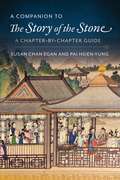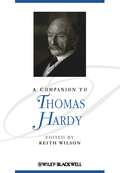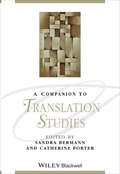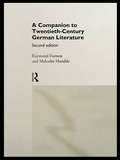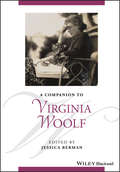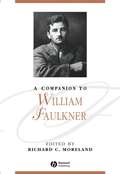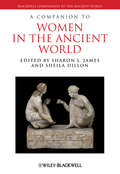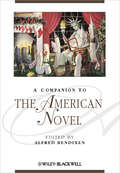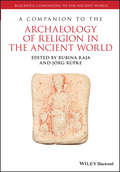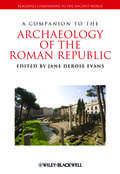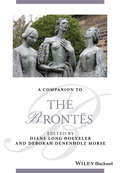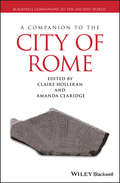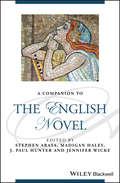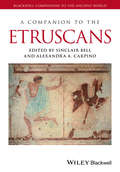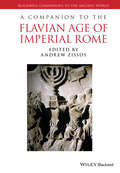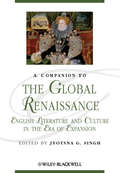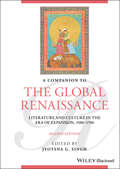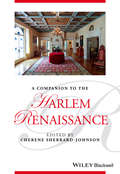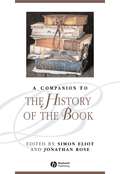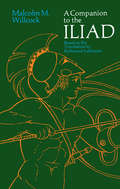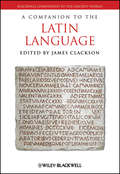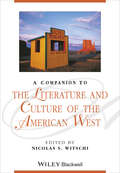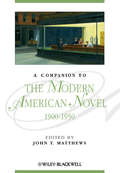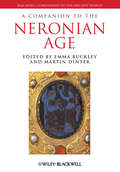- Table View
- List View
A Companion to The Story of the Stone: A Chapter-by-Chapter Guide
by Susan Chan Egan Kenneth Hsien-Yung PaiThe Story of the Stone (also known as Dream of the Red Chamber) is widely held to be the greatest work of Chinese literature, beloved by readers ever since it was first published in 1791. The story revolves around the young scion of a mighty clan who, instead of studying for the civil service examinations, frolics with his maidservants and girl cousins. The narrative is cast within a mythic framework in which the protagonist’s rebellion against Confucian strictures is guided by a Buddhist monk and a Taoist priest. Embedded in the novel is a biting critique of imperial China’s political and social system.This book is a straightforward guide to a complex classic that was written at a time when readers had plenty of leisure to sort through the hundreds of characters and half a dozen subplots that weave in and out of the book’s 120 chapters. Each chapter of the companion summarizes and comments on each chapter of the novel. The companion provides English-speaking readers—whether they are simply dipping into this novel or intent on a deep analysis of this masterpiece—with the cultural context to enjoy the story and understand its world.The book is keyed to David Hawkes and John Minford’s English translation of The Story of the Stone and includes an index that gives the original Chinese names and terms.
A Companion to Thomas Hardy (Blackwell Companions to Literature and Culture #190)
by Keith WilsonThrough original essays from a distinguished team of international scholars and Hardy specialists, A Companion to Thomas Hardy provides a unique, one-volume resource, which encompasses all aspects of Hardy's major novels, short stories, and poetry Informed by the latest in scholarly, critical, and theoretical debates from some of the world's leading Hardy scholars Reveals groundbreaking insights through examinations of Hardy’s major novels, short stories, poetry, and drama Explores Hardy's work in the context of the major intellectual and socio-cultural currents of his time and assesses his legacy for subsequent writers
A Companion to Translation Studies (Blackwell Companions to Literature and Culture)
by Sandra Bermann Catherine PorterThis companion offers a wide-ranging introduction to the rapidly expanding field of translation studies, bringing together some of the best recent scholarship to present its most important current themes Features new work from well-known scholars Includes a broad range of geo-linguistic and theoretical perspectives Offers an up-to-date overview of an expanding field A thorough introduction to translation studies for both undergraduates and graduates Multi-disciplinary relevance for students with diverse career goals
A Companion to Twentieth-Century German Literature
by Raymond Furness Malcolm HumbleContaining entries on over four hundred authors of fiction, poetry and drama from Germany, Austria and Switzerland, this invaluable work of reference presents material of a range and depth that no other book on the subject in English attains. For the second edition, the entries have been updated to include the most recent works of German literature. A number of new entries have been added, dealing in particular with the East German literary scene and the changing literary landscape after reunification. In addition to basic biographical facts, the Companion offers summaries, information on involvement in literary groups and political developments, schools and movements, critical terms and aspects of the other arts, including film.
A Companion to Virginia Woolf (Blackwell Companions to Literature and Culture)
by Jessica BermanA Companion to Virginia Woolf is a thorough examination of her life, work, and multiple contexts in 33 essays written by leading scholars in the field. Contains insightful and provocative new scholarship and sketches out new directions for future research Approaches Woolf’s writing from a variety of perspectives and disciplines, including modernism, post-colonialism, queer theory, animal studies, digital humanities, and the law Explores the multiple trajectories Woolf’s work travels around the world, from the Bloomsbury Group, and the Hogarth Press to India and Latin America Situates Woolf studies at the vanguard of contemporary literature scholarship and the new modernist studies
A Companion to William Faulkner (Blackwell Companions to Literature and Culture #7)
by Richard C. MorelandThis comprehensive Companion to William Faulkner reflects the current dynamic state of Faulkner studies. Explores the contexts, criticism, genres and interpretations of Nobel Prize-winning writer William Faulkner, arguably the greatest American novelist Comprises newly-commissioned essays written by an international contributor team of leading scholars Guides readers through the plethora of critical approaches to Faulkner over the past few decades Draws upon current Faulkner scholarship, as well as critically reflecting on previous interpretations
A Companion to Women in the Ancient World (Blackwell Companions to the Ancient World #165)
by Sharon L. James Sheila DillonSelected by Choice as a 2012 Outstanding Academic Title Awarded a 2012 PROSE Honorable Mention as a Single Volume Reference/Humanities & Social Sciences A Companion to Women in the Ancient World presents an interdisciplinary, methodologically-based collection of newly-commissioned essays from prominent scholars on the study of women in the ancient world. The first interdisciplinary, methodologically-based collection of readings to address the study of women in the ancient world Explores a broad range of topics relating to women in antiquity, including: Mother-Goddess Theory; Women in Homer, Pre-Roman Italy, the Near East; Women and the Family, the State, and Religion; Dress and Adornment; Female Patronage; Hellenistic Queens; Imperial Women; Women in Late Antiquity; Early Women Saints; and many more Thematically arranged to emphasize the importance of historical themes of continuity, development, and innovation Reconsiders much of the well-known evidence and preconceived notions relating to women in antiquity Includes contributions from many of the most prominent scholars associated with the study of women in antiquity
A Companion to the American Novel (Blackwell Companions to Literature and Culture #182)
by Alfred BendixenFeaturing 37 essays by distinguished literary scholars, A Companion to the American Novel provides a comprehensive single-volume treatment of the development of the novel in the United States from the late 18th century to the present day. Represents the most comprehensive single-volume introduction to this popular literary form currently available Features 37 contributions from a wide range of distinguished literary scholars Includes essays on topics and genres, historical overviews, and key individual works, including The Scarlet Letter, Moby Dick, The Great Gatsby, Beloved, and many more.
A Companion to the Ancient Novel (Blackwell Companions to the Ancient World #117)
by Edmund P. Cueva Shannon N. ByrneThis companion addresses a topic of continuing contemporary relevance, both cultural and literary. Offers both a wide-ranging exploration of the classical novel of antiquity and a wealth of close literary analysis Brings together the most up-to-date international scholarship on the ancient novel, including fresh new academic voices Includes focused chapters on individual classical authors, such as Petronius, Xenophon and Apuleius, as well as a wide-ranging thematic analysis Addresses perplexing questions concerning authorial expression and readership of the ancient novel form Provides an accomplished introduction to a genre with a rising profile
A Companion to the Archaeology of Religion in the Ancient World (Blackwell Companions to the Ancient World)
by J Rubina Raja X00F6 Rg R X00FC PkeA Companion to the Archaeology of Religion in the Ancient World presents a comprehensive overview of a wide range of topics relating to the practices, expressions, and interactions of religion in antiquity, primarily in the Greco-Roman world. • Features readings that focus on religious experience and expression in the ancient world rather than solely on religious belief • Places a strong emphasis on domestic and individual religious practice • Represents the first time that the concept of “lived religion” is applied to the ancient history of religion and archaeology of religion • Includes cutting-edge data taken from top contemporary researchers and theorists in the field • Examines a large variety of themes and religious traditions across a wide geographical area and chronological span • Written to appeal equally to archaeologists and historians of religion
A Companion to the Archaeology of the Roman Republic
by Jane Derose EvansA Companion to the Archaeology of the Roman Republic offers a diversity of perspectives to explore how differing approaches and methodologies can contribute to a greater understanding of the formation of the Roman Republic.Brings together the experiences and ideas of archaeologists from around the world, with multiple backgrounds and areas of interestOffers a vibrant exploration of the ways in which archaeological methods can be used to explore different elements of the Roman Republican periodDemonstrates that the Republic was not formed in a vacuum, but was influenced by non-Latin-speaking cultures from throughout the Mediterranean regionEnables archaeological thinking in this area to be made accessible both to a more general audience and as a valuable addition to existing discourseInvestigates the archaeology of the Roman Republican period with reference to material culture, landscape, technology, identity and empire
A Companion to the Brontes
by Deborah Denenholz Morse Diane Long HoevelerA Companion to the Brontës brings the latest literary research and theory to bear on the life, work, and legacy of the Brontë family. Includes sections on literary and critical contexts, individual texts, historical and cultural contexts, reception studies, and the family's continuing influence Features in-depth articles written by well-known and emerging scholars from around the world Addresses topics such as the Gothic tradition, film and dramatic adaptation, psychoanalytic approaches, the influence of religion, and political and legal questions of the day - from divorce and female disinheritance, to worker reform Incorporates recent work in Marxist, feminist, post-colonial, and race and gender studies
A Companion to the City of Rome (Blackwell Companions to the Ancient World)
by Claire Holleran Amanda ClaridgeA Companion to the City of Rome presents a series of original essays from top experts that offer an authoritative and up-to-date overview of current research on the development of the city of Rome from its origins until circa AD 600. Offers a unique interdisciplinary, closely focused thematic approach and wide chronological scope making it an indispensible reference work on ancient Rome Includes several new developments on areas of research that are available in English for the first time Newly commissioned essays written by experts in a variety of related fields Original and up-to-date readings pertaining to the city of Rome on a wide variety of topics including Rome’s urban landscape, population, economy, civic life, and key events
A Companion to the English Novel
by Jennifer Wicke J. Paul Hunter Madigan Haley Stephen ArataThis collection of authoritative essays represents the latest scholarship on topics relating to the themes, movements, and forms of English fiction, while chronicling its development in Britain from the early 18th century to the present day. Comprises cutting-edge research currently being undertaken in the field, incorporating the most salient critical trends and approaches Explores the history, evolution, genres, and narrative elements of the English novel Considers the advancement of various literary forms - including such genres as realism, romance, Gothic, experimental fiction, and adaptation into film Includes coverage of narration, structure, character, and affect; shifts in critical reception to the English novel; and geographies of contemporary English fiction Features contributions from a variety of distinguished and high-profile literary scholars, along with emerging younger critics Includes a comprehensive scholarly bibliography of critical works on and about the novel to aid further reading and research
A Companion to the Etruscans (Blackwell Companions to the Ancient World #143)
by Sinclair Bell Alexandra A. CarpinoThis new collection presents a rich selection of innovative scholarship on the Etruscans, a vibrant, independent people whose distinct civilization flourished in central Italy for most of the first millennium BCE and whose artistic, social and cultural traditions helped shape the ancient Mediterranean, European, and Classical worlds. Includes contributions from an international cast of both established and emerging scholars Offers fresh perspectives on Etruscan art and culture, including analysis of the most up-to-date research and archaeological discoveries Reassesses and evaluates traditional topics like architecture, wall painting, ceramics, and sculpture as well as new ones such as textile archaeology, while also addressing themes that have yet to be thoroughly investigated in the scholarship, such as the obesus etruscus, the function and use of jewelry at different life stages, Greek and Roman topoi about the Etruscans, the Etruscans’ reception of ponderation, and more Counters the claim that the Etruscans were culturally inferior to the Greeks and Romans by emphasizing fields where the Etruscans were either technological or artistic pioneers and by reframing similarities in style and iconography as examples of Etruscan agency and reception rather than as a deficit of local creativity
A Companion to the Flavian Age of Imperial Rome (Blackwell Companions to the Ancient World)
by Andrew ZissosA Companion to the Flavian Age of Imperial Rome provides a systematic and comprehensive examination of the political, economic, social, and cultural nuances of the Flavian Age (69–96 CE). Includes contributions from over two dozen Classical Studies scholars organized into six thematic sections Illustrates how economic, social, and cultural forces interacted to create a variety of social worlds within a composite Roman empire Concludes with a series of appendices that provide detailed chronological and demographic information and an extensive glossary of terms Examines the Flavian Age more broadly and inclusively than ever before incorporating coverage of often neglected groups, such as women and non-Romans within the Empire
A Companion to the Global Renaissance: English Literature and Culture in the Era of Expansion (Blackwell Companions to Literature and Culture #114)
by Jyotsna G. SinghFeaturing twenty one newly-commissioned essays, A Companion to the Global Renaissance: English Literature and Culture in the Era of Expansion demonstrates how today's globalization is the result of a complex and lengthy historical process that had its roots in England's mercantile and cross-cultural interactions of the sixteenth and seventeenth centuries. An innovative collection that interrogates the global paradigm of our period and offers a new history of globalization by exploring its influences on English culture and literature of the early modern period. Moves beyond traditional notions of Renaissance history mainly as a revival of antiquity and presents a new perspective on England's mercantile and cross-cultural interactions with the New and Old Worlds of the Americas, Africa, and the East, as well with Northern Europe. Illustrates how twentieth-century globalization was the result of a lengthy and complex historical process linked to the emergence of capitalism and colonialism Explores vital topics such as East-West relations and Islam; visual representations of cultural 'others'; gender and race struggles within the new economies and cultures; global drama on the cosmopolitan English stage, and many more
A Companion to the Global Renaissance: Literature and Culture in the Era of Expansion, 1500-1700 (Blackwell Companions to Literature and Culture)
by Jyotsna G. SinghA COMPANION TO THE GLOBAL RENAISSANCE An innovative collection of original essays providing an expansive picture of globalization across the early modern world, now in its second editionA Companion to the Global Renaissance: Literature and Culture in the Era of Expansion, 1500–1700, Second Edition provides readers with a deeper and more nuanced understanding of both macro and micro perspectives on the commercial and cross-cultural interactions of the sixteenth and seventeenth centuries. Covering a uniquely broad range of literary and cultural materials, historical contexts, and geographical regions, the Companion’s varied chapters offer interdisciplinary perspectives on the implications of early modern concepts of commerce, material and artistic culture, sexual and cross-racial encounters, conquest and enslavement, social, artistic, and religious cross-pollinations, geographical “discoveries,” and more.Building upon the success of its predecessor, this second edition of A Companion to the Global Renaissance radically extends its scope by moving beyond England and English culture. Newly-commissioned essays investigate intercultural and intra-cultural exchanges, transactions, and encounters involving England, European powers, Eastern kingdoms, Africa, Islamic empires, and the Americas, within cross-disciplinary frameworks. Offering a complex and multifaceted view of early modern globalization, this new edition:Demonstrates the continuing global “turn” in Early Modern Studies through original essays exploring interconnected exchanges, transactions, and encountersProvides significantly expanded coverage of global interactions involving England, European powers such as Portugal, Spain, and The Netherlands, Eastern empires such as Japan, and the Ottoman, Safavid, and Mughal empiresIncludes a Preface and Afterword, as well as a revised and expanded Introduction summarizing the evolving field of Global Early Modern Studies and describing the motifs and methodologies informing the essays within the volumeExplores an array of new subjects, including an exceptional woman traveler in Eurasia, the Jesuit presence in Mughal India and sixteenth-century Japan, the influence of Mughal art on an Amsterdam painter-cum-poet, the cultural impact of Eastern trade on plays and entertainments in early modern London, Safavid cultural disseminations, English and Portuguese slaving practices, the global contexts of English pattern poetry, and global lyric transmissions across culturesA wide-ranging account of the global expansions and interactions of the period, A Companion to the Global Renaissance: Literature and Culture in the Era of Expansion, 1500–1700, Second Edition remains essential reading for early modern scholars and students ranging from undergraduate and graduate students to more advanced scholars and specialists in the field.
A Companion to the Harlem Renaissance (Blackwell Companions to Literature and Culture)
by Cherene Sherrard-JohnsonA Companion to the Harlem Renaissance presents a comprehensive collection of original essays that address the literature and culture of the Harlem Renaissance from the end of World War I to the middle of the 1930s. Represents the most comprehensive coverage of themes and unique new perspectives on the Harlem Renaissance available Features original contributions from both emerging scholars of the Harlem Renaissance and established academic “stars” in the field Offers a variety of interdisciplinary features, such as the section on visual and expressive arts, that emphasize the collaborative nature of the era Includes “Spotlight Readings” featuring lesser known figures of the Harlem Renaissance and newly discovered or undervalued writings by canonical figures
A Companion to the History of the Book
by Jonathan Rose Simon EliotThe history of the book is a relatively new discipline that looks at books as historical artifacts as well as carriers of literary texts. It considers not just printed volumes, but any texts that have been reproduced and distributed by any means--clay tablets as well as manuscripts. Here scholars from various humanities set out the fundamentals of the field: methods and approaches, periodicals and other book-like entities, and issues. A long section also surveys the history of the material text, from the world before the codex, the book beyond the West, and the codex in the West since 400.
A Companion to the Iliad
by Malcolm M. WillcockThose who are able to read Homer in Greek have ample recourse to commentaries, but the vast majority who read the Iliad in translation have not been so well served--the many available translations contain few, if any, notes. For these readers, Malcolm M. Willcock provides a line-by-line commentary that explains the many factual details, mythological allusions, and Homeric conventions that a student or general reader could not be expected to bring to an initial encounter with the Iliad. The notes, which always relate to particular lines in the text, have as their prime aim the simple, factual explanation of things the inexperienced reader would be unlikely to have at his or her command (What is a hecatomb? Who is Atreus' son?). Second, they enhance an appreciation of the Iliad by illuminating epic style, Homer's methods of composition, the structure of the work, and the characterization of the major heroes. The "Homeric Question," concerning the origin and authorship of the Iliad, is also discussed. Professor Willcock's commentary is based on Richmond Lattimore's translation--regarded by many as the outstanding translation of the present generation--but it may be used profitably with other versions as well. This clearly written commentary, which includes an excellent select bibliography, will make one of the touchstones of Western literature accessible to a wider audience.
A Companion to the Latin Language (Blackwell Companions to the Ancient World #132)
by James ClacksonA Companion to the Latin Language presents a collection of original essays from international scholars that track the development and use of the Latin language from its origins to its modern day usage. Brings together contributions from internationally renowned classicists, linguists and Latin language specialists Offers, in a single volume, a detailed account of different literary registers of the Latin language Explores the social and political contexts of Latin Includes new accounts of the Latin language in light of modern linguistic theory Supplemented with illustrations covering the development of the Latin alphabet
A Companion to the Literature and Culture of the American West
by Nicolas S. WitschiA Companion to the Literature and Culture of the American West presents a series of essays that explore the historic and contemporary cultural expressions rooted in America's western states.Offers a comprehensive approach to the wide range of cultural expressions originating in the westFocuses on the intersections, complexities, and challenges found within and between the different historical and cultural groups that define the west's various distinctive regionsAddresses traditionally familiar icons and ideas about the west (such as cowboys, wide-open spaces, and violence) and their intersections with urbanization and other regional complexitiesFeatures essays written by many of the leading scholars in western American cultural studies
A Companion to the Modern American Novel, 1900 - 1950 (Blackwell Companions to Literature and Culture #151)
by John T. MatthewsThis cutting-edge Companion is a comprehensive resource for the study of the modern American novel. Published at a time when literary modernism is being thoroughly reassessed, it reflects current investigations into the origins and character of the movement as a whole. Brings together 28 original essays from leading scholars Allows readers to orient individual works and authors in their principal cultural and social contexts Contributes to efforts to recover minority voices, such as those of African American novelists, and popular subgenres, such as detective fiction Directs students to major relevant scholarship for further inquiry Suggests the many ways that “modern”, “American” and “fiction” carry new meanings in the twenty-first century
A Companion to the Neronian Age
by Emma Buckley Martin DinterAn authoritative overview and helpful resource for students and scholars of Roman history and Latin literature during the reign of Nero.The first book of its kind to treat this era, which has gained in popularity in recent yearsMakes much important research available in English for the first timeFeatures a balance of new research with established critical linesOffers an unusual breadth and range of material, including substantial treatments of politics, administration, the imperial court, art, archaeology, literature and reception studiesIncludes a mix of established scholars and groundbreaking new voicesIncludes detailed maps and illustrations
